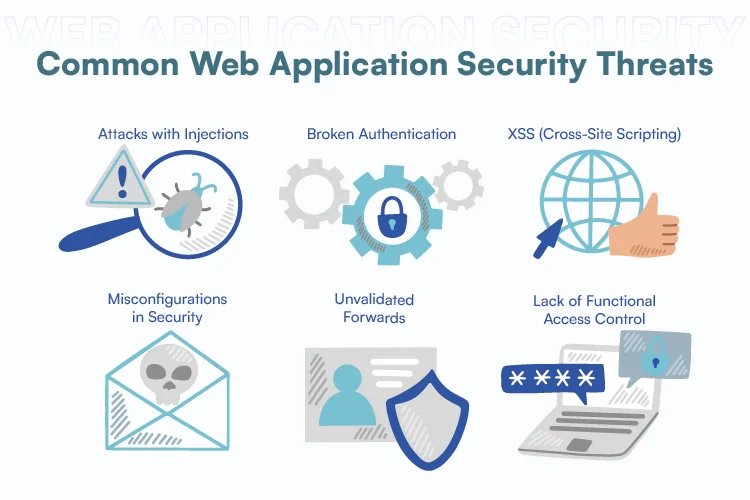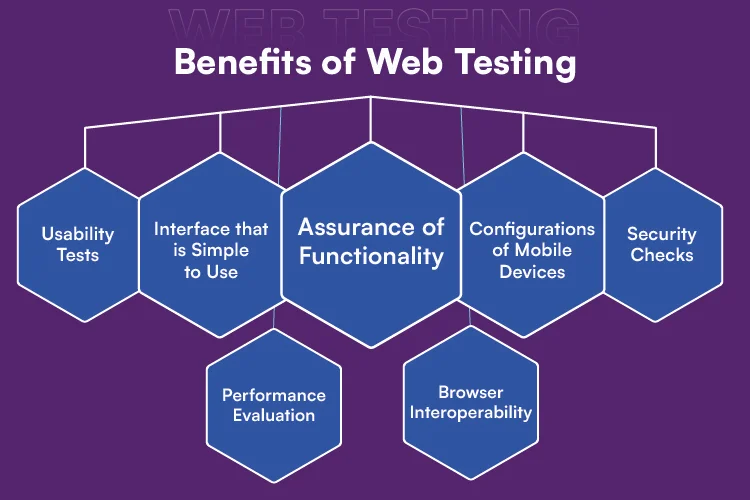Websites have become commonplace in today’s increasing digital environment, with every organization and even individuals owning one. With technological advancements, it is now quite simple to create a website for any business.
Having a professional and flawless website is vital for online promotion and establishing a first impression on website visitors. For example, suppose you’ve designed and launched a website for your company. But what if others criticize your website for having grammatical issues, being inaccessible on mobile devices, or having photos that do not appear in some browsers or take a long time to load.
All these issues necessitate the use of web testing. Web testing ensures that your website is error-free by detecting faults and defects before they go live. Simply put, web testing involves testing several components of a web application to ensure the website’s proper functionality.
Furthermore, web testing is an important aspect of assembling any web application or website because you don’t want to invest a significant amount of time and money in constructing this web application just to run into quick problems upon release.
Web Application Testing:
A web application is a computer program that is typically kept on a remote server and distributed via the Internet via a browser interface.
Web application testing is a software testing technique that is used exclusively to test web-hosted applications, in which the web application interfaces, and other functionalities are tested.
Common Web Application Security Threats:

Threats are evolving on a daily basis, with advanced hacker components stealing data from vulnerable online apps. As a result, it is critical to recognize typical security dangers in order to act appropriately.
The most common risks are listed down below:
Attacks with Injections:
- Web apps that are prone to injection accept unclean input. To influence the server, enter code into an input area.
- SQL injections, Cross-Site Scripting, Email Header Injection, and other techniques could jeopardize databases and administrative rights.
Broken Authentication:
- Authentication vulnerabilities are caused by improperly implemented authentication and session management tokens.
- Because of this weakness, hackers can steal a user’s identity, access sensitive data, and misuse ID rights.
XSS (Cross-Site Scripting):
- This attack injects malicious code into website programs, causing them to run in the browsers of victims.
- Implementation takes user session IDs, defaces websites, and redirects to malicious sites, allowing phishing to take place.
Misconfigurations in Security:
- According to the 2017 OWASP Top 10, this is the most common web application security threat.
- This flaw is caused by developers and administrators “forgetting” to alter default usernames, reference IDs, error messages, and so on.
Unvalidated Forwards:
- Almost every website has a redirect. This verification avoids URL-based attacks.
- Phishing and virus sites can be directed by malicious actors. Phishers use this weakness to gain confidence.
Lack of Functional Access Control:
- Because of the lack of Function Level Access Control, attackers have access to functions and features that normal users should not have.
- URL manipulation, such as IDOR, provides these features.
These risks have the potential to cause serious security breaches, leading to data loss, system damage, financial loss, and even legal consequences. Security testing can aid in the prevention of these attacks by finding flaws before bad actors exploit them.
Benefits of Web Testing:

The aim of employing testing tools and the requirement of web testing are determined by the benefits of web testing. So, let’s have a look at the advantages of web testing.
Assurance of Functionality:
Your React Native developer may have neglected some details throughout the development stage, which is why you require assistance. This type of assistance is provided by QA organizations, who will ensure that your business logic and app perform properly. Remember that certain simple problems were overlooked throughout the development stage and were skipped due to the lack of website testing services.
Configurations of Mobile Devices:
Only one out of every three customers visit your website using a desktop. “According to research, more than 65% of website visitors access the content using a mobile device. That is why software testing services like Brand – Test Fort are so important.” You don’t want your website to be buggy or frozen on mobile devices; these issues frequently develop during the testing stage.
Browser Interoperability:
Most software solutions are designed for the Chrome browser first. It’s a good pick because Chrome has over 63% of the market, but dozens of other browsers also compete. To attract more consumers, you must also test the performance of your bespoke online product in all other browsers. A startup offshore QA company can assist you in getting cross-browser features right.
Performance Evaluation:
If your product or platform is slow or bugged, no one will want to utilize your services, place orders, browse your store’s inventory, and so on. Your retail product discount will be ineffective because clients will be unable to place purchases through your website. To avoid this, you should use a software testing services provider. There are QA testing services and solutions available that will continuously monitor overall performance.
Security Checks:
The main advantage of website security testing is that it detects flaws and potential intrusions in your website. Cybersecurity is a major concern for both small and large businesses. As a result, outsourcing security inspections to a testing organization reduces the likelihood of actual hacking attempts. The only method to assure the security of your customers’ financial information is to do website security testing.
Usability Tests:
Features that you implemented in the early stages of your commerce website may become obsolete shortly after the project’s launch. That is why you require the services of an outsourcing software testing business to correct all usability issues. The focus of website usability testing is on flexibility and ensuring that your product is user-friendly.
Interface that is Simple to Use:
Designers can make mistakes as well, and it is preferable to find them during the testing stage. Your commerce project can only benefit from early detection of user interface issues. The cost of such testing will pay off in the long run.
These were top benefits of web testing, which will help any website to function smoothly and clear out all the unnecessary risks from the website.
Testing Automation Best Practices:
Testing automation best practices are of using the right tools and framework and retaining records for testing analysis. Organizations that follow these best practices can not only obtain better testing results, but also save expenses, improve productivity, and speed the delivery of high-quality software products.
Here are the pointers related to the best practices:
- Make an Automation Strategy: Create a strategy for determining which test cases should be automated. The strategy for identification and an approach for automation should be outlined in the plan.
- Determine which Test Cases can be Automated: All the test cases cannot and should not be automated. You should categorize your test cases into broad categories such as: Test Cases that are only executed in specific scenarios, Test Cases that touch a critical piece of functionality and should be run before release, and so on. More such categories can be identified, and your test cases can be assigned to them.
- Create Test Cases: After determining which test cases to automate, it is critical to develop scenarios that explain the test’s aim, requirements, expected results, and failure criteria. Determine checkpoints to confirm the test’s success.
- Early & Frequent Testing: For the best results, begin testing as soon as feasible. Furthermore, repeating tests helps you identify more faults, which can be repaired early on rather than at the deployment stage. Identifying faults early in a project saves the business money and time.
- Select the Best Automated Testing Software & Tool: The automation testing software you have chosen should not only support the technology of your application, but it should also be updated to support the latest advancements. When evaluating your customer-facing portal, one of the most important tool selection criteria should be that the tool works on all platforms and browsers that your customers are likely to use.
- Divide your Automated Testing Skills & Efforts: Divide duties like developing scripts, writing test cases, and so on based on your team’s skills.
- Make Test Data: Any test automation effort is incomplete without test data. You should take great care to generate adequate test data that exercises the majority of your application’s components, including boundary conditions and edge situations.
- Make Reusable & Easy-to-Maintain Test Cases: The capacity to reuse is critical. Make sure the scripts are modular, easy to comprehend, and easy to maintain. Break up your test cases in a way that encourages reuse. Make short test cases that can be incorporated into larger workflows. This will simplify your life.
Web Testing Frameworks:
Cuneiform leverages the Selenium and Playwright web testing frameworks, which allow us to execute web testing efficiently and effectively, resulting in excellent websites that run smoothly without errors or buffering.
Selenium Web Testing Framework:
The Selenium Framework is a coding framework that streamlines and simplifies code maintenance. If frameworks are not used, users may store “code” and “data” in the same location, rendering the code and data neither reusable nor intelligible. Frameworks can have both positive and negative repercussions. They can boost code reusability, portability, reduce script maintenance costs, and improve code readability.
Playwright Web Testing Framework:
Playwright is a popular web testing tool that makes it simple to test current online apps. One of the most important characteristics is its ability to reduce flaky tests by automatically waiting for items to be actionable before conducting actions. It enables developers to create scripts that interact with web sites and replicate real-world user behavior such as button clicks and form filling.
Playwright may test web applications on a variety of browser platforms and browser versions, including desktop and mobile devices. It offers headless testing, which allows tests to be run without requiring a graphical user interface. This enables tests to be executed in a CI/CD pipeline or on a remote server, which is perfect for testing apps that must run on several operating systems or devices.
Our web testing team commonly works with the web testing frameworks Selenium and Playwright. These well-known frameworks let developers write scripts that interact with websites and resemble real-world user behavior. Furthermore, these frameworks can have both positive and negative repercussions. As a result, these characteristics will assist in performing better web testing.




